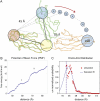Secondary and tertiary structure elasticity of titin Z1Z2 and a titin chain model
- PMID: 17496052
- PMCID: PMC1948054
- DOI: 10.1529/biophysj.107.105528
Secondary and tertiary structure elasticity of titin Z1Z2 and a titin chain model
Abstract
The giant protein titin, which is responsible for passive elasticity in muscle fibers, is built from approximately 300 regular immunoglobulin-like (Ig) domains and FN-III repeats. While the soft elasticity derived from its entropic regions, as well as the stiff mechanical resistance derived from the unfolding of the secondary structure elements of Ig- and FN-III domains have been studied extensively, less is known about the mechanical elasticity stemming from the orientation of neighboring domains relative to each other. Here we address the dynamics and energetics of interdomain arrangement of two adjacent Ig-domains of titin, Z1, and Z2, using molecular dynamics (MD) simulations. The simulations reveal conformational flexibility, due to the domain-domain geometry, that lends an intermediate force elasticity to titin. We employ adaptive biasing force MD simulations to calculate the energy required to bend the Z1Z2 tandem open to identify energetically feasible interdomain arrangements of the Z1 and Z2 domains. The finding is cast into a stochastic model for Z1Z2 interdomain elasticity that is generalized to a multiple domain chain replicating many Z1Z2-like units and representing a long titin segment. The elastic properties of this chain suggest that titin derives so-called tertiary structure elasticity from bending and twisting of its domains. Finally, we employ steered molecular dynamics simulations to stretch individual Z1 and Z2 domains and characterize the so-called secondary structure elasticity of the two domains. Our study suggests that titin's overall elastic response at weak force stems from a soft entropic spring behavior (not described here), from tertiary structure elasticity with an elastic spring constant of approximately 0.001-1 pN/A and, at strong forces, from secondary structure elasticity.
Figures









Similar articles
-
Tertiary and secondary structure elasticity of a six-Ig titin chain.Biophys J. 2010 Mar 17;98(6):1085-95. doi: 10.1016/j.bpj.2009.12.4192. Biophys J. 2010. PMID: 20303866 Free PMC article.
-
Molecular origin of the hierarchical elasticity of titin: simulation, experiment, and theory.Annu Rev Biophys. 2011;40:187-203. doi: 10.1146/annurev-biophys-072110-125325. Annu Rev Biophys. 2011. PMID: 21332356 Review.
-
Mechanically driven contour-length adjustment in rat cardiac titin's unique N2B sequence: titin is an adjustable spring.Circ Res. 1999 Jun 11;84(11):1339-52. doi: 10.1161/01.res.84.11.1339. Circ Res. 1999. PMID: 10364572
-
Titin extensibility in situ: entropic elasticity of permanently folded and permanently unfolded molecular segments.J Cell Biol. 1998 Feb 23;140(4):853-9. doi: 10.1083/jcb.140.4.853. J Cell Biol. 1998. PMID: 9472037 Free PMC article.
-
Titin elasticity in the context of the sarcomere: force and extensibility measurements on single myofibrils.Adv Exp Med Biol. 2000;481:179-202; discussion 203-6. doi: 10.1007/978-1-4615-4267-4_11. Adv Exp Med Biol. 2000. PMID: 10987073 Review.
Cited by
-
A comparative study of ribosomal proteins: linkage between amino acid distribution and ribosomal assembly.BMC Biophys. 2013 Oct 23;6(1):13. doi: 10.1186/2046-1682-6-13. BMC Biophys. 2013. PMID: 24152303 Free PMC article.
-
The allosteric role of the Ca2+ switch in adhesion and elasticity of C-cadherin.Biophys J. 2008 Jun;94(12):4621-33. doi: 10.1529/biophysj.107.125591. Epub 2008 Mar 7. Biophys J. 2008. PMID: 18326636 Free PMC article.
-
Dynamic strength of titin's Z-disk end.J Biomed Biotechnol. 2010;2010:838530. doi: 10.1155/2010/838530. Epub 2010 Apr 19. J Biomed Biotechnol. 2010. PMID: 20414364 Free PMC article.
-
The Assembling and Contraction Mechanisms of Striated Muscles.Front Chem. 2018 Nov 30;6:570. doi: 10.3389/fchem.2018.00570. eCollection 2018. Front Chem. 2018. PMID: 30555818 Free PMC article.
-
Physical characterization of nanoparticle size and surface modification using particle scattering diffusometry.Biomicrofluidics. 2016 Sep 21;10(5):054107. doi: 10.1063/1.4962992. eCollection 2016 Sep. Biomicrofluidics. 2016. PMID: 27703593 Free PMC article.
References
-
- Wang, K. 1996. Titin/connectin and nebulin: giant protein ruler of muscle structure and function. Adv. Biophys. 33:123–134. - PubMed
-
- Erickson, H. 1997. Stretching single protein modules: titin is a weird spring. Science. 276:1090–1093. - PubMed
-
- Maruyama, K. 1997. Connectin/titin, a giant elastic protein of muscle. FASEB J. 11:341–345. - PubMed
-
- Linke, W. 2000. Stretching molecular springs: elasticity of titin filaments in vertebrate striated muscle. Histol. Histopath. 15:799–811. - PubMed
-
- Tskhovrebova, L., and J. Trinick. 2003. Titin: properties and family relationships. Nat. Rev. Mol. Cell Biol. 4:679–689. - PubMed
Publication types
MeSH terms
Substances
Grants and funding
LinkOut - more resources
Full Text Sources
Miscellaneous

